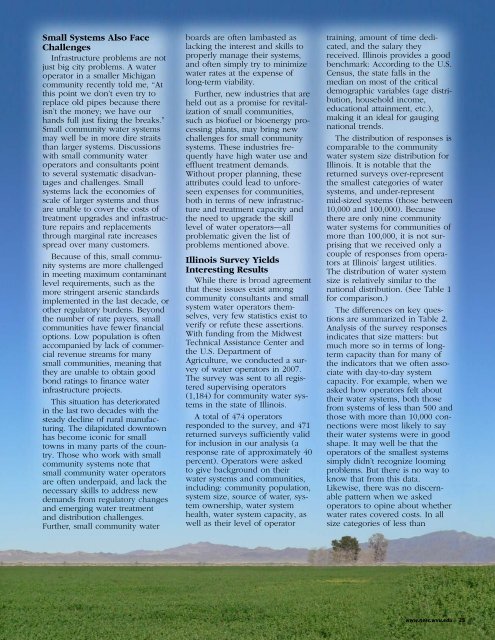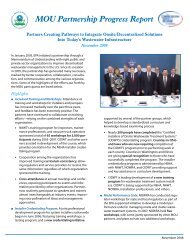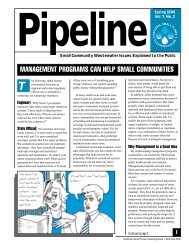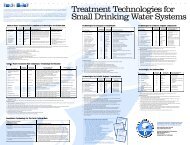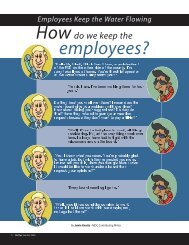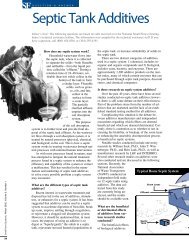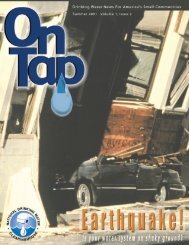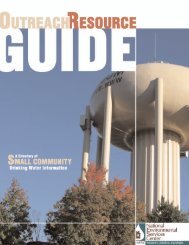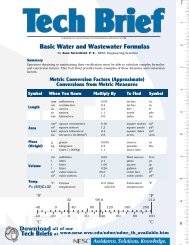Are Small Community Water Systems More at Risk than Other ...
Are Small Community Water Systems More at Risk than Other ...
Are Small Community Water Systems More at Risk than Other ...
Create successful ePaper yourself
Turn your PDF publications into a flip-book with our unique Google optimized e-Paper software.
<strong>Small</strong> <strong>Systems</strong> Also Face<br />
Challenges<br />
Infrastructure problems are not<br />
just big city problems. A w<strong>at</strong>er<br />
oper<strong>at</strong>or in a smaller Michigan<br />
community recently told me, “At<br />
this point we don’t even try to<br />
replace old pipes because there<br />
isn’t the money; we have our<br />
hands full just fixing the breaks.”<br />
<strong>Small</strong> community w<strong>at</strong>er systems<br />
may well be in more dire straits<br />
<strong>than</strong> larger systems. Discussions<br />
with small community w<strong>at</strong>er<br />
oper<strong>at</strong>ors and consultants point<br />
to several system<strong>at</strong>ic disadvantages<br />
and challenges. <strong>Small</strong><br />
systems lack the economies of<br />
scale of larger systems and thus<br />
are unable to cover the costs of<br />
tre<strong>at</strong>ment upgrades and infrastructure<br />
repairs and replacements<br />
through marginal r<strong>at</strong>e increases<br />
spread over many customers.<br />
Because of this, small community<br />
systems are more challenged<br />
in meeting maximum contaminant<br />
level requirements, such as the<br />
more stringent arsenic standards<br />
implemented in the last decade, or<br />
other regul<strong>at</strong>ory burdens. Beyond<br />
the number of r<strong>at</strong>e payers, small<br />
communities have fewer financial<br />
options. Low popul<strong>at</strong>ion is often<br />
accompanied by lack of commercial<br />
revenue streams for many<br />
small communities, meaning th<strong>at</strong><br />
they are unable to obtain good<br />
bond r<strong>at</strong>ings to finance w<strong>at</strong>er<br />
infrastructure projects.<br />
This situ<strong>at</strong>ion has deterior<strong>at</strong>ed<br />
in the last two decades with the<br />
steady decline of rural manufacturing.<br />
The dilapid<strong>at</strong>ed downtown<br />
has become iconic for small<br />
towns in many parts of the country.<br />
Those who work with small<br />
community systems note th<strong>at</strong><br />
small community w<strong>at</strong>er oper<strong>at</strong>ors<br />
are often underpaid, and lack the<br />
necessary skills to address new<br />
demands from regul<strong>at</strong>ory changes<br />
and emerging w<strong>at</strong>er tre<strong>at</strong>ment<br />
and distribution challenges.<br />
Further, small community w<strong>at</strong>er<br />
boards are often lambasted as<br />
lacking the interest and skills to<br />
properly manage their systems,<br />
and often simply try to minimize<br />
w<strong>at</strong>er r<strong>at</strong>es <strong>at</strong> the expense of<br />
long-term viability.<br />
Further, new industries th<strong>at</strong> are<br />
held out as a promise for revitaliz<strong>at</strong>ion<br />
of small communities,<br />
such as biofuel or bioenergy processing<br />
plants, may bring new<br />
challenges for small community<br />
systems. These industries frequently<br />
have high w<strong>at</strong>er use and<br />
effluent tre<strong>at</strong>ment demands.<br />
Without proper planning, these<br />
<strong>at</strong>tributes could lead to unforeseen<br />
expenses for communities,<br />
both in terms of new infrastructure<br />
and tre<strong>at</strong>ment capacity and<br />
the need to upgrade the skill<br />
level of w<strong>at</strong>er oper<strong>at</strong>ors—all<br />
problem<strong>at</strong>ic given the list of<br />
problems mentioned above.<br />
Illinois Survey Yields<br />
Interesting Results<br />
While there is broad agreement<br />
th<strong>at</strong> these issues exist among<br />
community consultants and small<br />
system w<strong>at</strong>er oper<strong>at</strong>ors themselves,<br />
very few st<strong>at</strong>istics exist to<br />
verify or refute these assertions.<br />
With funding from the Midwest<br />
Technical Assistance Center and<br />
the U.S. Department of<br />
Agriculture, we conducted a survey<br />
of w<strong>at</strong>er oper<strong>at</strong>ors in 2007.<br />
The survey was sent to all registered<br />
supervising oper<strong>at</strong>ors<br />
(1,184) for community w<strong>at</strong>er systems<br />
in the st<strong>at</strong>e of Illinois.<br />
A total of 474 oper<strong>at</strong>ors<br />
responded to the survey, and 471<br />
returned surveys sufficiently valid<br />
for inclusion in our analysis (a<br />
response r<strong>at</strong>e of approxim<strong>at</strong>ely 40<br />
percent). Oper<strong>at</strong>ors were asked<br />
to give background on their<br />
w<strong>at</strong>er systems and communities,<br />
including: community popul<strong>at</strong>ion,<br />
system size, source of w<strong>at</strong>er, system<br />
ownership, w<strong>at</strong>er system<br />
health, w<strong>at</strong>er system capacity, as<br />
well as their level of oper<strong>at</strong>or<br />
training, amount of time dedic<strong>at</strong>ed,<br />
and the salary they<br />
received. Illinois provides a good<br />
benchmark: According to the U.S.<br />
Census, the st<strong>at</strong>e falls in the<br />
median on most of the critical<br />
demographic variables (age distribution,<br />
household income,<br />
educ<strong>at</strong>ional <strong>at</strong>tainment, etc.),<br />
making it an ideal for gauging<br />
n<strong>at</strong>ional trends.<br />
The distribution of responses is<br />
comparable to the community<br />
w<strong>at</strong>er system size distribution for<br />
Illinois. It is notable th<strong>at</strong> the<br />
returned surveys over-represent<br />
the smallest c<strong>at</strong>egories of w<strong>at</strong>er<br />
systems, and under-represent<br />
mid-sized systems (those between<br />
10,000 and 100,000). Because<br />
there are only nine community<br />
w<strong>at</strong>er systems for communities of<br />
more <strong>than</strong> 100,000, it is not surprising<br />
th<strong>at</strong> we received only a<br />
couple of responses from oper<strong>at</strong>ors<br />
<strong>at</strong> Illinois’ largest utilities.<br />
The distribution of w<strong>at</strong>er system<br />
size is rel<strong>at</strong>ively similar to the<br />
n<strong>at</strong>ional distribution. (See Table 1<br />
for comparison.)<br />
The differences on key questions<br />
are summarized in Table 2.<br />
Analysis of the survey responses<br />
indic<strong>at</strong>es th<strong>at</strong> size m<strong>at</strong>ters: but<br />
much more so in terms of longterm<br />
capacity <strong>than</strong> for many of<br />
the indic<strong>at</strong>ors th<strong>at</strong> we often associ<strong>at</strong>e<br />
with day-to-day system<br />
capacity. For example, when we<br />
asked how oper<strong>at</strong>ors felt about<br />
their w<strong>at</strong>er systems, both those<br />
from systems of less <strong>than</strong> 500 and<br />
those with more <strong>than</strong> 10,000 connections<br />
were most likely to say<br />
their w<strong>at</strong>er systems were in good<br />
shape. It may well be th<strong>at</strong> the<br />
oper<strong>at</strong>ors of the smallest systems<br />
simply didn’t recognize looming<br />
problems. But there is no way to<br />
know th<strong>at</strong> from this d<strong>at</strong>a.<br />
Likewise, there was no discernable<br />
p<strong>at</strong>tern when we asked<br />
oper<strong>at</strong>ors to opine about whether<br />
w<strong>at</strong>er r<strong>at</strong>es covered costs. In all<br />
size c<strong>at</strong>egories of less <strong>than</strong><br />
www.nesc.wvu.edu 25


